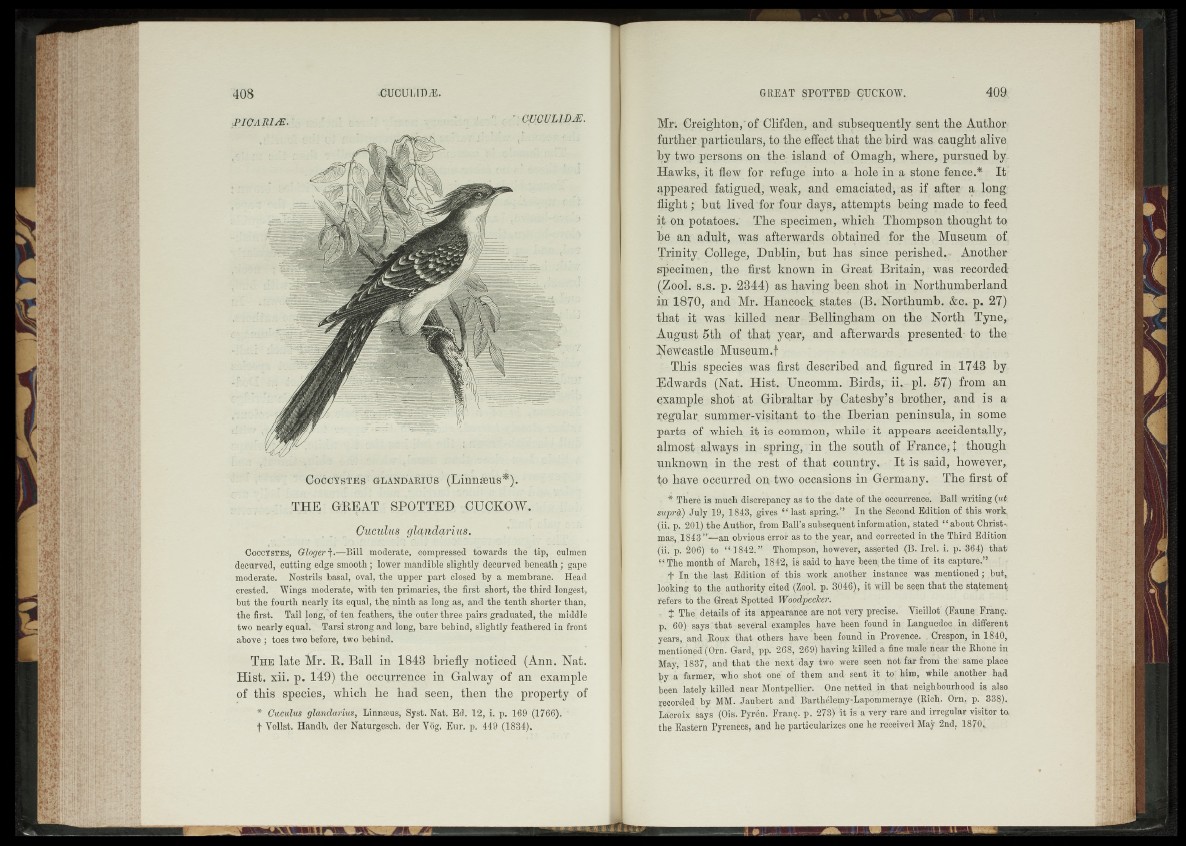
CoCCYSTES GLANDARIUS (L in n s eU S * ).
THE GREAT SPOTTED CUCKOW.
Guciilus glandarius.
Cocoystes, Gloger\ .—-Bill moderate, compressed towards the tip, culmen
decurved, cutting edge smooth; lower mandible slightly decurved beneath; gape
moderate. Nostrils basal, oval, the upper part closed by a membrane. Head
crested. Wings moderate, with ten primaries, the first short, the third longest,
but the fourth nearly its equal, the ninth as long as, and the tenth shorter than,
the first. Tail long, of ten feathers, the outer three pairs graduated, the middle
two nearly equal. Tarsi strong and long, bare behind, slightly feathered in front
above ; toes two before, two behind.
T h e late Mr. R. Ball in 1843 briefly noticed (Ann. Nat.
Hist. xii. p. 149) the occurrence in Galway of an example
of this species, which he had seen, then the property of
* Cuculus glcmdarius, Linnaeus, Syst. Nat. Ed. 12, i. p. 169 (1766).
f Yollst. Handb. der Naturgesch. der Yog. Eur. p. 449 (1834).
Mr. Creighton,'of Clifden, and subsequently sent the Author
further particulars, to the effect that the bird was caught alive
by two persons on the: island of Omagh, where, pursued by-
Hawks, it flew for refuge into a hole in a stone fence.* It
appeared fatigued, weak, and emaciated, as if after a long,
flight; but lived for four days, attempts being made to feed
it on potatoes. The specimen, which Thompson thought to
be an adult, was afterwards obtained for the Museum of
Trinity College, Dublin, but has since perished. - Another
specimen, the first known in Great Britain, was recorded-
(Zool. s.s. p. 2344) as having been shot in Northumberland
in 1870, and Mr. Hancock states (B. Northumb. &c. p. 27)
that it was killed near Bellingham on the North Tyne,
August 5th of that year, and afterwards presented- to the
Newcastle Museum.!
This species was first described and figured in 1743 by
Edwards. (Nat. Hist. Uncomm. Birds, ii. pi. 57) from an
example shot at Gibraltar by Catesby’s brother, and is a
regular summer-visitant to the Iberian peninsula, in some
parts of which it is common, while it appears accidentally,
almost always in spring, in the south of France,! though
unknown in the rest of that country. It is said, however,
to have occurred on, two occasions in Germany. The first of
* There is much discrepancy as to the date of the occurrence. Ball writing (ut
suprti) July 19, 1843, gives “ last spring.,” In the Second Edition of this work
(ii. p. 201) the Author, from Ball’s subsequent information, stated “ about Christ-,
mas,,1843”—an obvious error as to the year, and corrected in the Third Edition
(ii. p. 206) to “ 1842.” Thompson, however, asserted (B. Irel. i. p. 364) that
“ The month of March, 1842, is said to have been.; the time of its capture.”
f In the last Edition of this work another instance was mentioned; but,
looking to the authority cited (Zool. p. 3,046), it will be seen that the statement
refers to the Great Spotted Woodpecker.
, t The details of its appearance are not very precise. Yieillot (Faune Franq.
p. 60) says!that several examples have been found in Languedoc, in different
years, and Rou-x that others have been found in Provence. . Crespon, in 1840,
mentioned (Orn. Gard, pp. 268, 269) having killed a fine male hear the Rhone in
May, 1837, and that the next day two were seen not far from the: same place
by a farmer, who shot one of them and sent it to" him, while another had
been lately killed near Montpellier. One netted in that neighbourhood is also
recorded by MM. Jaubert and BarUndemy-Lapommeraye (Rich. Orn, p. 338).
LAcroix k y s (Ois. Pyren. Fran?, p. 273) it is a very rare and irregular visitor to
the Eastern Pyrenees, and he particularizes one he received May 2nd, 1870,
TTa